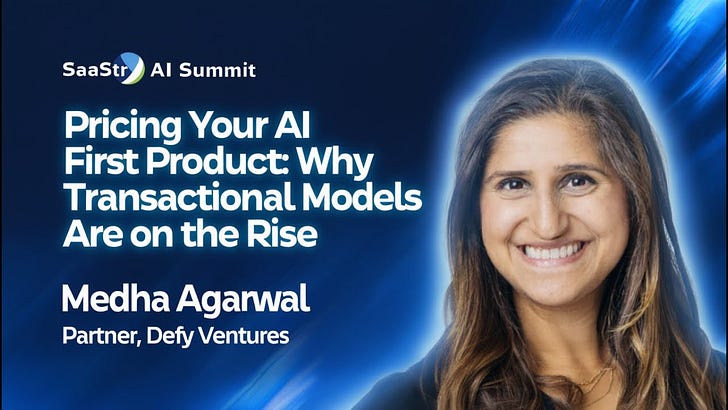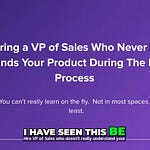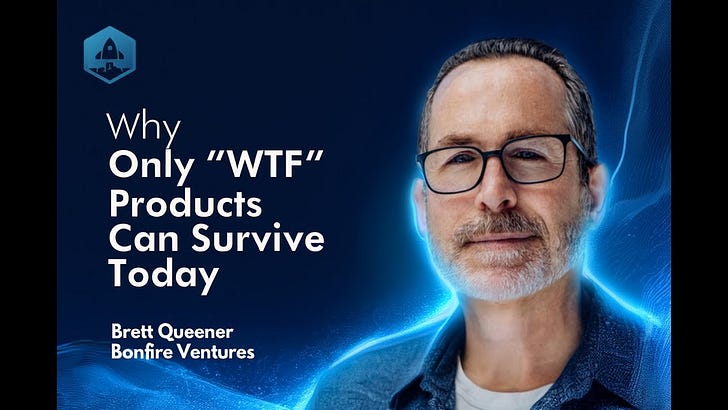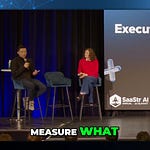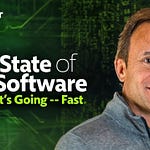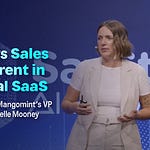As you grow from nothing to $100M and beyond, you will run into a unique set of challenges at every stage.
Spenser Skates, CEO and co-founder at Amplitude took the stage at SaaStr Annual 2023 to share four key lessons he learned building a great organization and a long-lasting sustainable business.
Amplitude is a digital analytics platform that started out of another failed startup with three co-founders. They have customers like Intuit, DoorDash, Atlassian, Walmart, Disney, NBC, and more. In 2021, Amplitude was listed on the NASDAQ, but that was just the beginning. Going public isn’t the end goal, and founders must see beyond that to build a generational tech company.
The four critical learnings of going from nothing to $100M+ in revenue are:
Maintain a culture of product innovation
Treat new products like a mini startup
Understand the three stages of executive hires
Make the early-stage to large organization mental switch
Let’s start with lesson one.
Lesson 1: Maintain a Culture of Product Innovation
This is super important, particularly in a tech business. Customers expect you to have the latest and greatest. The SaaS model means you can continue to iterate and make the product better for them.
The core challenge?
How to keep this up over time as you continue to grow and scale. It’s the hardest thing to achieve by far. A fallacy many people have is that your ability to innovate grows linearly with your number of employees.
For example, as you continue to add engineers and folks to your product development team, your rate to ship stuff and innovate goes up. A team of 100 people will be 10x more innovative than ten people, right?
Wrong.
What happens in practice is the opposite.
The three graphs above show what people expect to get as they grow their team, what they actually get, and then what your ideal is. Why would you grow your team if the ability to innovate goes down with a larger organization by default? Why wouldn’t you keep it small forever?
This is a natural occurrence because, as your code base gets larger, there are more people, so the ownership of great products and product success get diluted. Every individual’s ability to coordinate gets harder. The trick is to get the curve to look more like the third graph. But how do you actually get there?
One of the most overlooked parts of building and scaling great product development teams is setting the right structure and organization.
Setting the Right Structure and Organization
There’s an old saying where you ship your org chart. This is the root cause of why your ability to innovate slows down as you grow and scale. You want to build functional teams that drive innovation.
As a founder, you need to shift from thinking about how to drive all the innovation yourself. Instead, think about structure and how to create an organization with really clear guardrails and goals for each individual. This sounds basic, but every CEO who passes 50 engineers runs into this problem.
At Amplitude, they have a model where deep functional experts are the single responsible person for each of these areas. They’ve spent a lot of time on the executive level defining each area and giving responsibility across engineering, product management, and design.
You want to replicate the conditions of a startup team and manage the entire portfolio of “mini startups” as a leader, which you’ll learn more about in the next section.
There’s a second part to maintaining a culture of product innovation beyond structure and organization. And that’s culture itself.
You Have to Set The Tone of What You Value as an Organization
It’s not enough to set the org chart and give responsibilities out and go. You have to set the tone of what you value as an organization.
In the early days as a small team, it’s a you against the world mentality. It’s a natural feeling because you have to keep swimming. Otherwise, you’re dead. As you grow, you have to be explicit about setting this culture.
How does Amplitude do this?
“All hands” once a week.
At every meeting, there is a product demo showing what they shipped that week. You have to constantly talk about and beat the drum of innovation — celebrating, rewarding, and highlighting innovation to create a culture around it.
#Feature-release Slack channel.
Anytime a new feature goes out, it’s featured on this Slack channel. The product manager posts it with a GIF of how it works and which customers are using it. Amplitude looks at how much stuff is going through that channel each week. If there isn’t much, it’s a signal of a problem.
Week-long internal hackathons.
Twice a year, the entire product development team takes a week off of whatever project they’re working on to work on exciting things that could provide customer value. They present it to the company, and cool things come from it.
Early on, executives thought it was crazy for people to take a week off. But again, back to that culture of innovation. You have to provide opportunities for people to innovate if you want them to be innovative.
As you grow as an organization, you get more abstracted from your customers.
The final thing you can do to maintain a culture of innovation is to be ruthless in product prioritization. A question Spenser always asks is, “What customer uses it?”
The wonderful thing about B2B SaaS is customers will tell you what they want and then pay to use it if you build it. So, you can use that as a North Star. Build what your customers ask for.
Lesson #2: Treat New Products Like a Mini Startup
Many organizations get this wrong. One of the rules in SaaS is, as you get to $100M in revenue, you want to start to find new pieces of value outside your core offering.
What other adjacent things will the same buyer or user get value out of? Every company that makes it to a billion or more in ARR has done this successfully.
The challenge?
It’s really hard to do!
How do you capture lightning in a bottle a second time?
A lot of companies create a new product innovation team. But there’s a problem that often happens…They have this new team sit next to the central product team and be folded into the same efforts.
What works for a mature product at scale is completely opposite to what works for driving innovation for the first time.
Quarterly goals and a long-term product roadmap might work for a mature product, but a new product could change tomorrow. Many things that work for a mature product are huge distractions for early innovative teams. Your job as a leader is to sequester them off and protect them from distractions so they can innovate quickly.
The takeaway —
Protect the people driving innovation. They don’t need to worry about:
How it integrates with an existing product.
The long-term roadmap.
What metric to optimize.
Being in compliance.
Their only job is to get something out there that has paying customers. As you grow, a lot of people want to be part of the new, hot, and innovative thing. As a leader, you have to deliberately isolate them from that.
Lesson #3: Understand the Three Stages of Executive Hires
There are three stages of executive hiring.
Early-stage
Mid-stage
Late-stage
This lesson isn’t talked about much because it’s uncomfortable — what makes someone a good fit for one stage vs. another? Spenser’s learnings are based on each stage.
Early-Stage Executives Make Things Happen
In the early stages of a company, not a ton is going on in your business yet. You might not have a product, no one cares, and you have zero brand awareness.It’s you against the world. You need an executive who is strong in operating in that environment of making something happen out of nothing.
The biggest mistake early-stage companies make is…
Hiring a big executive from Microsoft or Amazon who isn’t used to operating in a scrappy startup. When you’re a few million in revenue, you need executives to embrace that idea of getting a lot done without a lot of resources.
Mid-Stage Executives Help You Scale
As you get to tens of millions in revenue, you transition as a SaaS company. Your product works. People are buying it. You aren’t just making stuff happen. You have something that works, and if you target this customer or have these conversations or product capabilities, they will do business with you.
Now, the goal is to scale successfully to get to $10M, $20M, $50M, and beyond.
You change from someone scrappy and making things happen to someone who takes something that works and scales it.
How do you hire your nth account executive?
How do you hire your nth engineer?
How do you repeat that webinar that worked and do it 100 times over?
That’s a different type of executive — a mid-stage scale executive.
Why is the transition hard?
Because some of the early on folks who were really good at making things happen may not be good at this stage. Creating deliberate, systematic processes that work at scale is a new kind of challenge. You need a specific skill set that differs from early-stage — accurate forecasting, territory strategies, etc.
Late-Stage Executive Hires Are Good at Hiring
At late stages of $100M+, you are no longer hiring executives who do the work themselves. Their job is to hire other leaders who then do the scaling work and build out the teams.
This one was hard culturally for Amplitude because they didn’t want people who sit in an office all day hiring out of a Rolodex and not delivering value themselves. But this is what you need at the late stage.
Once you get to $100M and beyond, there’s so much complexity in the organization with so many different functions. One leader isn’t capable of leading all those functions by themselves. The late-stage executive superpower is hiring other leaders.
There is an emotional element to this, which is one of the hardest parts of this stage.
It’s difficult to move on from people who have helped build your company.
Larry Ellison, co-founder of Oracle, is a ruthless businessman, and he even said letting valuable people go was the most difficult thing he ever had to do in business.
Lesson #4: Making the Switch from Early-Stage Founder to Large-Org Executive
The way you manage is very different as a large-organization executive. You think more about talent and how to get the right people to do things. That’s the rate limiter on the growth of Amplitude. It sounds obvious, but it’s hard to practice.
Spenser used to obsess about every single person at Amplitude getting a great experience. He held onto that idea for too long and tried to maintain it all the way to 200 people — checking in with and meeting with each of them. It worked for a while, with super high engagement and low attrition.
Until it didn’t.
He could no longer be in the weeds with everyone, and suddenly, attrition went from 10% to 30% overnight. He realized he was covering for organizational dysfunction instead of holding leaders accountable. He was covering those gaps.
You can do unscalable things up to a certain point.
And then you can’t. You want leaders who step up and are direct with other leaders instead of coming to you for help. Anytime anyone has to come to you first, you become a bottleneck. Your job isn’t to lead by example but to evaluate performance.
Key Takeaways
Never stop iterating or innovating, especially later in your growth. It’s the single biggest lever for long-term organizational success. Iteration gets harder as you scale, but it fuels output.
Treat new products as mini startups — replicate the experience in as many ways as possible.
A founder’s job is to ensure a company’s executive team is set up for its next stage of growth. Change is a hard but necessary part of scaling.
The early-stage founder to large-organization executive mental switch is essential for sustained growth.







